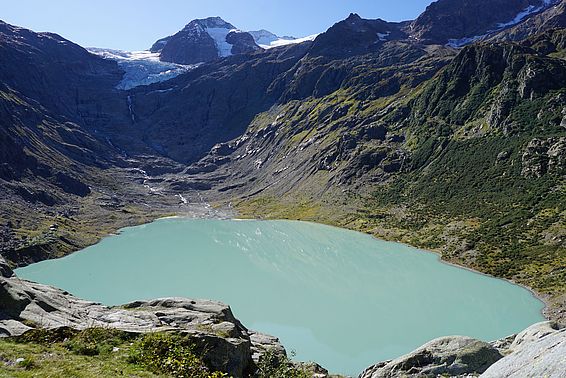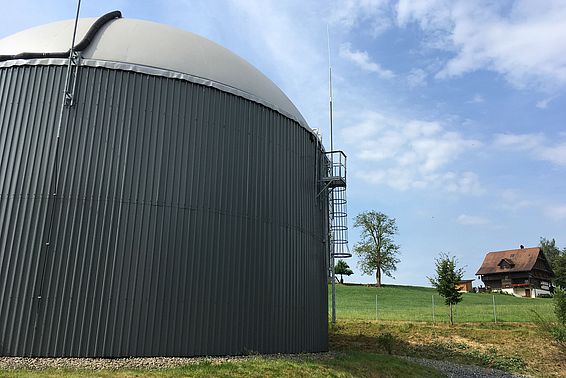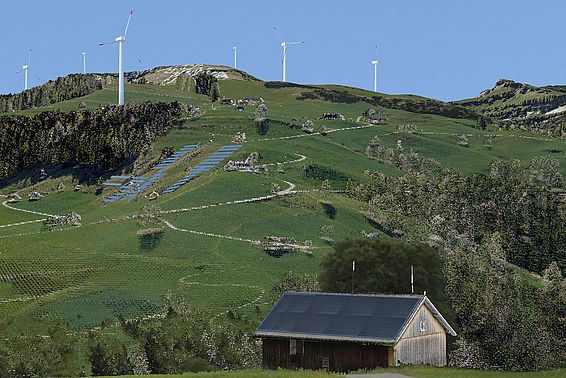05.12.2019 | Reinhard Lässig | News WSL
This year’s Forum for Knowledge («Forum für Wissen») at the Swiss Federal Institute for Forest, Snow and Landscape Research WSL in Birmensdorf examined how stepping up the use of renewable resources might help to make progress in the energy transition. The potential of biomass, water, wind and solar power in Switzerland is undeniably high. However, both public and political willingness to act and acceptance are prerequisites for attaining any energy targets.
Switzerland is making only slow progress on the way to shaping a society that generates its energy exclusively from renewable resources. There are many examples of hesitancy to switch from fossil fuels to renewable resources. Progress in constructing new photovoltaic plants is sluggish, even though every third house roof in the country would need to be fitted with solar panels to achieve the objectives of the Swiss Energy Strategy 2050. And although a majority of the population voted in favour of phasing out nuclear energy, the public is proving reluctant to accept the 700 or so new wind turbines that would be needed nationwide.
Consumption is another source of contradiction, according to environmental economist Irmi Seidl (WSL): «While businesses’ use of energy and raw materials is increasingly efficient, any savings made are being nullified by higher consumption.» For this reason, people should be more closely involved in realising the energy transition, added Katrin Bernath, a municipal councillor in Schaffhausen: «Among the public, we need to start at the grassroots level, though politicians and businesses will also have to do their bit».
The success of any measures associated with the Swiss Energy Strategy hinges on public support. A joint WSL and ETH Zurich survey on energy systems in the landscape showed that a mix of wind and solar power plants prompted a more favourable rating than mere clusters of wind turbines. In near-natural high mountain regions and hilly landscapes (Jura, the Alpine foothills), energy plants were far less tolerated than on the Swiss Plateau. And a total absence of photovoltaic facilities was less well received than their inclusion on a small to medium scale. Boris Salak (WSL) showed: «Even though the public is starting to read the signs of the times, achieving the energy transition will take a great deal of persuasion».
Plan big, but pay attention to details
The Energy Act passed in 2017 was undoubtedly a bold decision, but its implementation has been insufficient, mostly comprising only small-scale projects. Together with WSL, the electricity companies of the Canton of Zurich (EKZ) are currently implementing a vigorous, ecologically interesting project on smart-light technology on selected streets in Greater Zurich. Using a new type of LED lamp and automatic motion detectors, the stretch of street just ahead of a vehicle can systematically be illuminated, then extinguished again when the vehicle has passed. This innovative lighting concept not only saves energy, it also has a positive impact on nocturnal insects, as Janine Bolliger (WSL) found out.
Biomass could be a trump card for the energy transition. First and foremost, large quantities of farm manure are available: «The energy contained in it corresponds to roughly 10% of the output of nuclear fuel and even 24% of our natural gas imports», underlined Vanessa Burg (WSL). In addition, the resulting biogas can be stored and is thus available around the clock, unlike wind and solar energy.
Water: energy source, storage medium and habitat all in one?
Hydropower generates more than half the energy produced in Switzerland, but has almost reached its full potential. As a result of climate change, pumped-storage hydroelectricity (PSH) plants are becoming increasingly important for other uses, too, as more seasonal and local water shortages are expected in the future. «If glacial meltwaters disappear, Alpine reservoirs could compensate for water shortages on the Swiss Plateau if properly managed », said Elke Kellner (WSL). «This should be taken into account when renegotiating PSH concessions.»
Water is also a habitat. This ought to be borne in mind when water is used for power generation, heating or cooling purposes. «Energy consumption can cool rivers and lakes or make them warmer, on top of climate change. Protecting accessible cooler refuges may enable heat-sensitive fish, like trout and grayling, to temporarily avoid high temperatures in a water body», said Martin Schmid from the Swiss Federal Institute of Aquatic Science and Technology (Eawag).
Involve businesses and society
This year’s Forum for Knowledge showed that Switzerland is undergoing an exciting change that cannot be controlled solely by politicians. To make sure that technologies and the findings arising from research are actually used to restructure the energy system in practice, greater involvement of businesses and society in the energy transition in general as well as in decisions and implementation processes is imperative. As the Forum’s organiser, Astrid Björnsen, pointed out: «Many people have not yet grasped the fact that every individual is an actor in the energy transition, partly because the financial incentives encouraging them to act are still insufficient.»
Contact ¶
Links ¶
Copyright ¶
WSL and SLF provide image and sound material free of charge for use in the context of press contributions in connection with this media release. The transfer of this material to image, sound and/or video databases and the sale of the material by third parties are not permitted.



